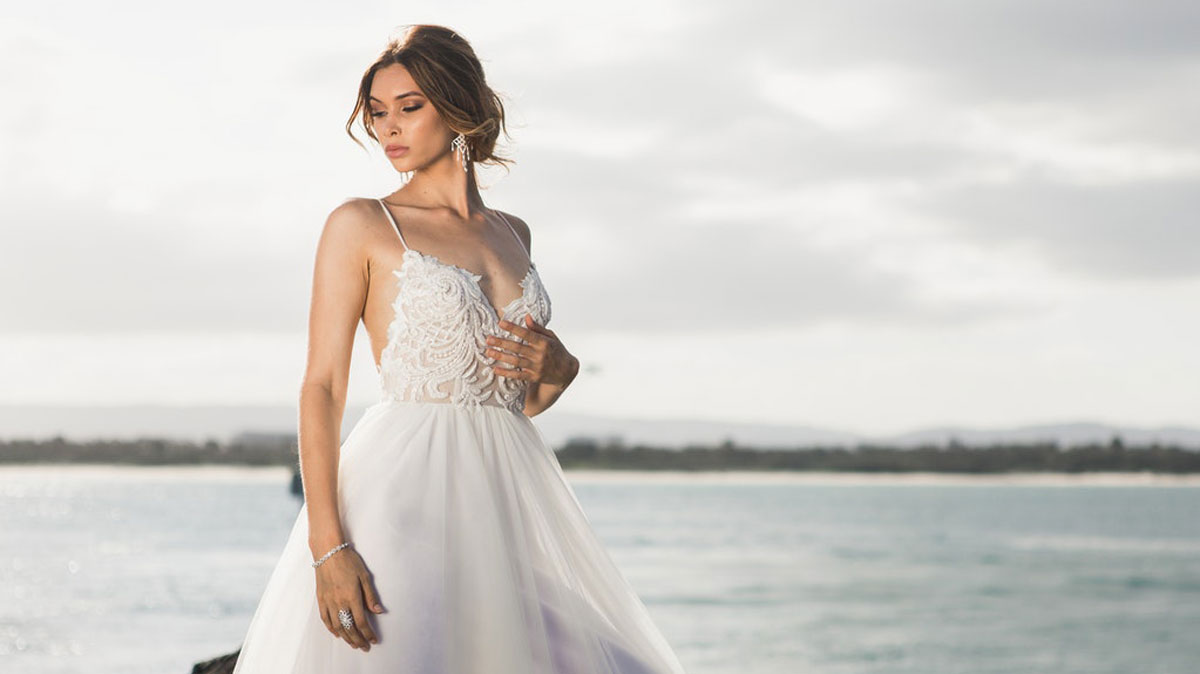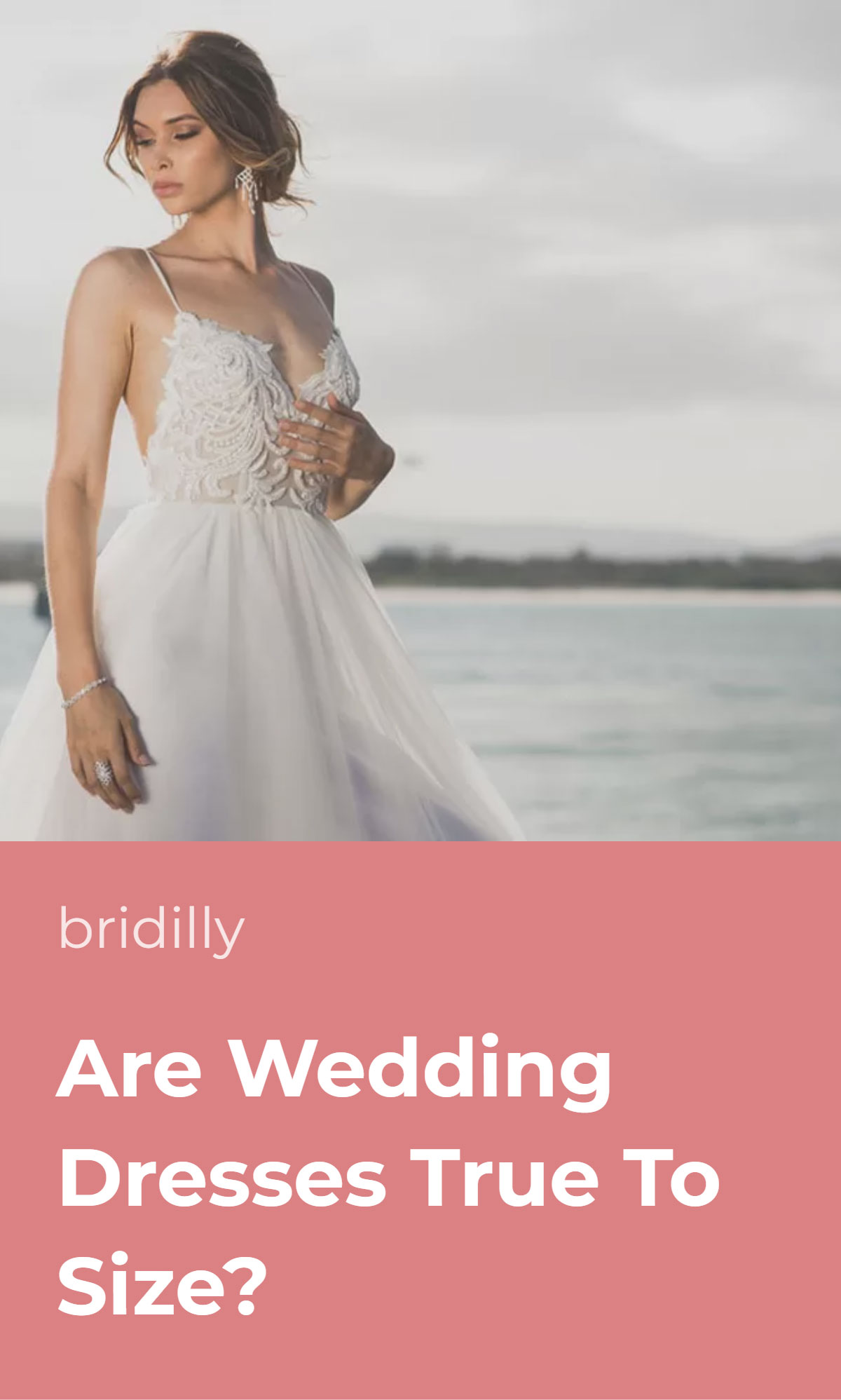Now that your bridal salon appointment is on the horizon, you may be wondering, “are wedding dresses true to size?”.
Sometimes, brides only find the difference between casual clothing and bridal wear sizing after shopping.
When the bridal stylist hands you a dress two sizes bigger than your regular size, it’s easy to get shocked and upset.
However, the number on the label isn’t worth your tears or ruining your health on a strict diet. The problem isn’t your sudden weight gain but the tricky wedding dress sizing.
Therefore, the best advice you could get when heading wedding dress shopping is to forget about the numbers and focus on the fit. Every bride is unique, and no sizing chart can dictate beauty standards.
Table of Contents [show]
The Truth About Wedding Dress Sizing
Most wedding dresses don’t correspond with the standard clothing sizing charts. You may wear size 6 in ready-wear clothing and need a size 10 in wedding dresses because they nearly always run 1-3 sizes small.
This can lead to increased stress because every bride wants to look her best on her big day, and many become extra-aware about their weight. Remember that sizing is just a number.
The small sizing problem is prevalent at trunk shows because most wedding dresses presented to the public are hot off the runway, but it’s also common in bridal salons carrying international designer gowns.
Are All Wedding Dresses Sized The Same?
If every wedding dress were two sizes bigger than your ready-wear sizing, choosing the suitable gown would be simple.
Unfortunately, different designers can have different sizing, so buying a wedding gown without trying it on is tricky.
You likely know that size 8 jeans from Zara and H&M can fit slightly differently. However, the discrepancy between brand sizing is often drastic with wedding dresses.
If you’re shopping online, refer to the designer’s size chart. You may also read reviews online to determine how the designer’s dresses fit different body types and whether the sizing chart is accurate.
Typically, American designer wedding gown sizing better corresponds with ready-wear sizing than European designer sizing.
Mass bridal wear brands, like David’s Bridal, also tend to have more accurate sizing than high-fashion designers like Vera Wang.
History of Wedding Dress Sizing
So, what’s the reason behind the awkward wedding dress sizing system? To find the cause of the issue, we must learn about the sizing system history and the vanity sizing phenomenon.
The universal sizing system is a relatively recent invention dating a couple of centuries.
The first sizing chart was created in 1589 by Spanish sewist Juan de Alcega, but sewing garments according to sizing patterns only became widespread by the 19th century.
The fashion of that era largely influenced British and European women’s wear sizing of the 19th century. Women used to wear corsets that altered their body shape over time.
For this reason, the waist measurements were typically much smaller than in corresponding modern sizes. Furthermore, food wasn’t as affordable as nowadays, so people were slimmer on average.
Over time, fashion trends evolved, and women ditched the corsets, bringing back natural body shape. Plus, mass food production has led to an increase in the average clothing size in developed countries.
Although the British and European sizing system has adapted to the changes, it has become stagnant since the early 20th century. Meanwhile, the sizing system in the US was constantly evolving.
In 1939, the US government funded statistical research to create a standardized sizing system according to 15,000 women measurements. That’s how our familiar sizing system appeared.
However, in the 1980s, US clothing manufacturers started downgrading size labels to encourage customers to buy the garment, taking advantage of consumer body image aspirations. This phenomenon is known as vanity sizing.
Waist measurements that corresponded with size 12 in the 1950s nowadays correspond with size 8 or 6. Now, we’ve come to the root of the problem – vanity sizing is only a thing in casual clothing, particularly in the US.
While the ready-wear clothing sizing system was changing, bridal wear sizing has stuck in the past.
Furthermore, most bridal wear designers are based in Europe or Britain and use local sizing charts that run smaller than American.
In other words, bridal designers aren’t trying to make you larger than you are, and European women aren’t smaller than American women. The issue is sizing guidelines based on body types from many decades ago.
How To Find Your Wedding Dress Size
The history of wedding dress sizing may be exciting, but it doesn’t help much in determining which size of gown you need. Unfortunately, there’s no way to find a wedding dress size that would work for any designer.
That’s daunting for brides shopping for a wedding dress online. However, you don’t have to rely on luck alone if you can’t visit a bridal salon.
If you already have particular bridal wear designers in mind, find their sizing charts online and compare them with your measurements. Typically, the sizing is dictated by bust, waist, and hip measurements.
When measuring the bust, wear the bra you plan to wear at your wedding. Wrap the measuring tape at the fullest part of your bust.
The waist is measured at the narrowest part of your torso, between the ribcage and the hips. When making measurements, don’t suck in your stomach because you want a comfortable dress that doesn’t restrict movement.
Like the bust, the hips should be measured around the fullest part. Asking someone to help is a good idea because you should stand straight while measuring.
If you’re in between sizes, always take a larger size because taking in the seams is simpler than letting them out.
What if None of The Sizes Fit?
Many brides find that their body measurements don’t correspond with any of the sizes on the chart. For instance, one may have a size 12 bust, size 10 waist, and size 14 hips.
Wedding dresses rarely fit flawlessly, so most gowns require alterations. Choose a dress according to your largest measurements if none of the sizes works for you.
In our example, the bride should take a size 14 because it corresponds with her hip measurements. The waist and bust then can be taken in.
The extent of alterations can differ, but you likely won’t be able to skip them even if you have well-balanced proportions.
The wedding dress alterations costs may vary depending on the complexity, dress design, and seamstress. On average, brides in the US pay from $150 to $600. Ask your seamstress for estimation in advance.
Note that alterations of wedding dresses with intricate embellishments or made from delicate fabrics that require hand-stitching always cost more than minimalistic gowns.
As a rule of thumb, your wedding dress should arrive for alterations at least three months before the big day. Even if you only need to alter the waist, the changes may affect the entire dress fit and require more work.
Furthermore, each sewist has a different workload. Most sewists are extremely busy April through October, so book your fitting appointment sooner than later.
On the other hand, if you’re a winter bride, the sewist likely won’t be as busy.
Another common issue in wedding dress sizing is the length. Unlike jeans, wedding dresses usually have the same hem length.
Most designers make their dresses long enough to accommodate above-average height brides because shortening the hem is simpler than making it longer.
Standard wedding dresses are made for women at least 5’5-feet tall, so petite women often have difficulty finding a suitable gown.
The issue here is that petite and tall brides tend to have a different torso and arm length, affecting the dress bodice fit. Thankfully, some bridal wear brands release gowns in petite, regular, and tall variations.
The waist, bust, and hip circumference in petite and regular sizing also differ. For example, Vera Wang’s standard size 6 waist measurements are 33.5-34.5 inches, while petite size 6 waist measurements are 33-34 inches.
If you have non-standard measurements, ordering a made-to-measure wedding dress can be cheaper than altering a ready-made gown.
Ask your local bridal salons whether the gowns on the rack can be made to measure or create a design on your own and bring it to a tailor.
What’s Plus Size in Wedding Dresses?
The plus-size range of most ready-wear designers starts with size 14 and can go up to size 36, but as you already know, bridal wear sizing is different. Size 14 in casual wear usually corresponds with size 16 or 18 in wedding gowns.
To avoid confusion, bridal designers usually don’t consider size 14 in wedding dresses plus size.
Otherwise, women with an average casual clothing size couldn’t find a suitable dress on the rack and would have to search among plus-size gowns.
Although bridal salons typically only carry sample dresses in sizes 8, 10, and 12, many offer the same dresses in larger sizes. Some bridal designers have collections specifically for plus-sized brides.




















No Comments Add one
Leave a Comment